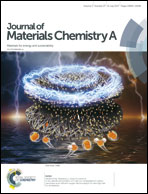Blend-electrospun poly(vinylidene fluoride)/polydopamine membranes: self-polymerization of dopamine and the excellent adsorption/separation abilities
Abstract
In this work, a certain amount of dopamine was firstly dissolved into the solution of poly(vinylidene fluoride) (PVDF) and then the fibrillar membranes were prepared through an electrospinning technology. Then, the self-polymerization of polydopamine (PDA) was triggered in a Tris–HCl buffer solution. The self-polymerization of PDA on the fiber surface and the microstructure of the PVDF/PDA membranes were systematically researched. The results demonstrated that the morphologies of the membranes were dependent upon the polymerization time of dopamine in the buffer solution. PDA homogeneously coated on the fiber surface, which greatly enhanced the hydrophilicity of the membranes. The adsorption abilities toward organic dyes and heavy metal ions of the PVDF/PDA membranes were evaluated using methylene blue (MB) and Cu2+ as the probe adsorbates. The results showed that the PVDF/PDA fibrillar membranes exhibited excellent adsorption ability and the experimental saturation adsorption capacities were 172.3 and 26.7 mg g−1 for MB and Cu2+, respectively. Further analysis based on adsorption kinetics, adsorption isotherms and thermodynamic parameters showed that the adsorption of MB follows the pseudo second-order model and the Langmuir adsorption model and the adsorption was a spontaneous process. Further results demonstrated that the PVDF/PDA membrane exhibited good regeneration ability after adsorbing MB. The oil/water separation ability of the PVDF/PDA membranes was also measured. The presence of the PDA coating layer greatly enhanced the separation efficiency of the membranes, and the maximum water flux was increased up to 729.3 L m−2 h−1 according to the measuring method applied in this work. The excellent adsorption and separation abilities endow the electrospun PVDF/PDA fibrillar membranes with great potential applications in wastewater treatment.



 Please wait while we load your content...
Please wait while we load your content...